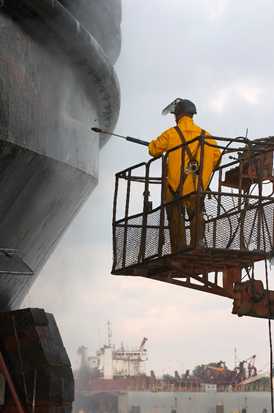Center for Maritime Safety and Health Studies

A worker pressure washes a vessel prior to repair. Photo: Thinkstock
Shipyards
Shipyard workers are involved in the manufacture, repair, maintenance, and dismantling of boats and ships. The work involves activities such as welding and cutting steel, machining, plumbing, electrical work, rigging, painting, cleaning and removal of paint and other coverings, and cleanup of chemical and fuel residues.
There are a variety of workplace hazards found in shipyards. These include chemical hazards such as exposure to asbestos, welding fumes, and a variety of paints, solvents, and fuels. There are also physical hazards such as noise exposure, extreme temperatures, vibration, awkward body positions, and the risk of musculoskeletal injuries. Hot work, confined space entry, exposure to hazardous air, and work done at height all increase the risk of injury. Shipyard workers may work above water while a vessel is docked, introducing a fall hazard that may lead to drowning.
Chronic illness is also a concern for long term shipyard workers. Respiratory illness caused by fume and smoke inhalation and exposure to heavy metals, such as lead, are of particular concern in shipyard workers. Excess cancer morbidity has been detected in several groups of shipyard workers, especially cancers of the respiratory system1-4, with welders appearing to be at particular risk5. Another study found an increased risk of leukemia in electricians and welders working in a naval nuclear shipyard6.
There are approximately 160,000 workers7 employed in shipyards in the U.S., spread across 26 states bordering coastal and inland waters. Between 2011 and 2014, there were 31 fatal accidents (4.9 per 100,000) among shipyard workers8, higher than the rate for all US workers. There were 37,400 nonfatal injuries/illnesses during the same period (5,855 per 100,000), nearly seven times higher than the rate for all U.S. workers. Shipyard workers have the second highest injury/illness rate of any maritime workers9.
References
- Blot WJ, Morris LE, Stroube R, Tagnon I, Fraumeni JF Jr [1980] Lung and Laryngeal Cancers in Relation to Shipyard Employment in Coastal Virginia. J Natl Cancer Inst; 65 (3): 571-575
- Edge J [1979] Incidence of Bronchial Carcinoma in Shipyard Workers with Pleural Plaques. Annals of the New York Academy of Sciences; 330: 289-294
- Melkild A, Langard S, Andersen A, Tonnessen JN [1989] Incidence of cancer among welders and other workers in a Norwegian shipyard. Scand J Work Environ Health; 15(6):387-394
- Sanden A, Jarvholm B [1987] Cancer morbidity in Swedish shipyard workers 1978-1983. Int Arch Occup Environ Health; 59(6):623
- Danielsen TE, Langard S, Anderson A [1996] Incidence of cancer among Norwegian boiler welders. Occupational and Enviornmental Medicine; 53:231-234
- Stern FB, Waxweiler R, Beaumont J, Lee ST, Rinsky R, Zumwalde R, et al. [1986] A case-control study of leukemia at a naval nuclear shipyard. Am J Epidemiol; 123(6):980-992
- BLS [2016] NAICS 3366 ship and boat building, all US, all ownerships, 2006 – 2016. In Quarterly Census of Employment and Wages. Washington DC: Bureau of Labor Statistics, https://data.bls.gov/cew/apps/data_views/data_views.htm#tab=Tables
- BLS [2016] NAICS 3366 Fatalities in all sectors, all US, all ownerships, 2011 – 2014. In Census of Fatal Occupational Injuries. Washington DC: Bureau of Labor Statistics, https://www.bls.gov/data/#injuries
- BLS [2016] Table 2. Numbers of nonfatal occupational injuries and illnesses by industry and case types, 2011 – 2014. In Survey of Occupational Injuries and Illnesses. Washington DC: Bureau of Labor Statistics, https://www.bls.gov/iif/oshsum.htm
- Page last reviewed: July 6, 2017
- Page last updated: July 18, 2017
- Content source:
Error processing SSI file


 ShareCompartir
ShareCompartir